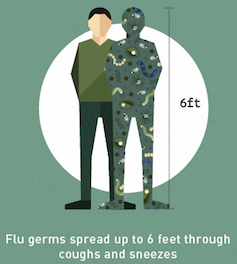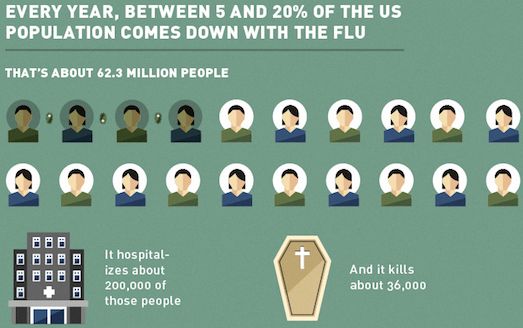What is influenza “the flu”?
Flu season is upon us here in the United States, and it’s not something to be taken lightly. I’m very passionate about flu education and information, and that’s why I’m breaking down everything you need to know about the flu, the influenza virus, and the flu vaccines into three different posts over the next few weeks.
Here, I want to focus on what the “flu” actually is, because I think the word “flu” is very misused in the United States. I often hear or overhear people saying something along the lines of, “I was throwing up all night, I must have the flu.” While the flu can cause vomiting and diarrhea, more often in children than adults, the true flu is actually a respiratory illness coupled with muscle aches, extreme tiredness, and sometimes a fever. Adults with bouts of vomiting and not the above mentioned common flu symptoms often have some other sort of stomach virus, possibly food poisoning, or something else.
The flu is also often confused with the common cold. Because both the cold and the flu are respiratory illnesses, sometimes it’s hard to tell what you have come down with. But, the flu tends to be a bit worse than a normal cold due to a fever, body aches, extreme tiredness, and a more intense dry cough. The typical cold usually results in a runny/stuffy nose and does not usually lead to serious complications, whereas the flu can lead to complications, life-threatening conditions, and even death.
So what is the flu, then?
 The flu is caused by the influenza virus. This virus is one that spreads quite easily through droplet transmission. That means that someone who is sick with the flu can cough, sneeze, even talk near an uninfected person and spread the sickness. Even from up to six feet away the droplets of someone sick with the flu virus can enter the mouths or noses of others, travel to the lungs, and infect them. And sometimes people even get sick after droplets land on a surface, the surface is touched by a healthy person, and the healthy person touches his nose or mouth.
The flu is caused by the influenza virus. This virus is one that spreads quite easily through droplet transmission. That means that someone who is sick with the flu can cough, sneeze, even talk near an uninfected person and spread the sickness. Even from up to six feet away the droplets of someone sick with the flu virus can enter the mouths or noses of others, travel to the lungs, and infect them. And sometimes people even get sick after droplets land on a surface, the surface is touched by a healthy person, and the healthy person touches his nose or mouth.
The flu is a respiratory illness, meaning infection usually occurs in the nose, throat, and lungs. And it’s highly contagious. Should you get the flu as an adult, you are infectious to others a day before the onset of symptoms and up to about 5-7 days after getting sick. But children can pass the virus on for even longer periods.
Once the virus enters your body, it multiplies and rapidly causes symptoms. These symptoms appear about 1-4 days after viral entry.
 Symptoms of the flu vary in severity include a fever/chills (not everyone who gets the flu will have a fever), cough, sore throat, runny/stuffy nose, muscle and body aches, headache, and extreme tiredness. Some people may experience vomiting and diarrhea, however these symptoms are most often seen in children.
Symptoms of the flu vary in severity include a fever/chills (not everyone who gets the flu will have a fever), cough, sore throat, runny/stuffy nose, muscle and body aches, headache, and extreme tiredness. Some people may experience vomiting and diarrhea, however these symptoms are most often seen in children.
Most people who get the flu recover in a few days to up to a few weeks. However, there are some people who will have  complications from the virus. Some complications include pneumonia, sinus infections, ear infections, bronchitis, and the worsening of pre-existing health problems. Sometimes severe complications can become life-threatening or even lead to death. Ninety percent of deaths occur in those 65 years and older1, however, serious complications can happen at any age. Those at high risk for complications include people over 65 years, people with chronic medical conditions, anyone living in a long-term care facility, pregnant women, young children (under 2 years), and anyone with a chronic heart, lung or kidney condition, diabetes, or weakened immune system.
complications from the virus. Some complications include pneumonia, sinus infections, ear infections, bronchitis, and the worsening of pre-existing health problems. Sometimes severe complications can become life-threatening or even lead to death. Ninety percent of deaths occur in those 65 years and older1, however, serious complications can happen at any age. Those at high risk for complications include people over 65 years, people with chronic medical conditions, anyone living in a long-term care facility, pregnant women, young children (under 2 years), and anyone with a chronic heart, lung or kidney condition, diabetes, or weakened immune system.
If you have the flu you want to most importantly, stay home. Also, stay hydrated, get plenty of rest, and use cool compresses to reduce discomfort of a fever. And seek medical attention immediately if you experience difficulty breathing, have pain/pressure in chest/abdomen, become very dizzy or confused, experience blu or purpling of the lips, have persistent vomiting, have experienced seizures, or have flu-like symptoms that improve and then return with a worsened fever and cough.
The influenza virus varies from year to year. And every year there are new flu vaccines available to the public. I will be covering the components and facts about these vaccines in a later post.
If you haven’t been vaccinated, and even if you have, you still want to avoid people who seem clearly sick. However, those who appear healthy are able to spread the flu before symptoms develop, so it’s also important to wash hands often with hot, soapy water. To avoid the spread of the flu within a home, isolate the sick person, wash hands often, don’t share eating utensils, and disinfect surfaces and objects regularly.
This flu season, just like every other, is unpredictable. It may be worse than any other ever seen or pass over us barely noticed by the majority of the population. If anything, understand what to look for in loved ones who may be sick with the flu and if you’re sick, stay home so you do not contribute to the spread the virus. And most importantly, if you want to limit your chances of getting the flu this year, get vaccinated.
Resources:
1. Centers for Disease Control and Prevention. www.cdc.gov
2. TheFlu.gov
3. Webmd. www.webmd.com
4. Medline Plus. National Institutes of Health. MedlinePlus.com
Photos Courtesy of OnlineEducation.net


